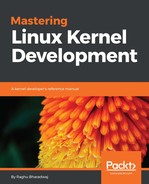The decision of which process to run depends on the priority of the process. Every process is labelled with a priority value, giving it an immediate position in terms of when it will be given CPU time. Priorities are fundamentally classified into dynamic and static priorities on *nix systems. Dynamic priorities are basically applied to normal processes dynamically by the kernel, considering various factors such as the nice value of the process, its historic behavior (I/O bound or processor bound), lapsed execution, and waiting time. Static priorities are applied to real-time processes by the user and the kernel does not change their priorities dynamically. Processes with static priorities are thus given higher priority when scheduling.
Processor bound process: These are processes that love to stick on to CPU time slices, as they require maximum utilization of the processor's computing capacity. Processes requiring heavy computations such as complex scientific calculations, and video rendering codecs are processor bound. Though the need for a longer CPU slice looks desirable, the expectation to run them under fixed time periods is not often a requirement. Schedulers on interactive operating systems tend to favor more I/O-bound processes than processor-bound ones. Linux, which aims for good interactive performance, is more optimized for faster response time, inclining towards I/O bound processes, even though processor-bound processes are run less frequently they are ideally given longer timeslices to run.
Processes can also be multi-faceted, with an I/O-bound process needing to perform serious scientific computations, burning the CPU.
The nice value of any normal process ranges between 19 (lowest priority) and -20 (highest priority), with 0 being the default value. A higher nice value indicates a lower priority (the process is being nicer to other processes). Real-time processes are prioritized between 0 and 99 (static priority). All these priority ranges are from the perspective of the user.
Kernel's perspective of priorities
Linux however looks at process priorities from its own perspective. It adds a lot more computation for arriving at the priority of a process. Basically, it scales all priorities between 0 to 139, where 0 to 99 is assigned for real-time processes and 100 to 139 represents the nice value range (-20 to 19).
